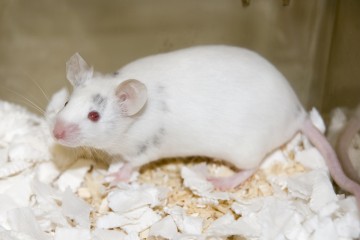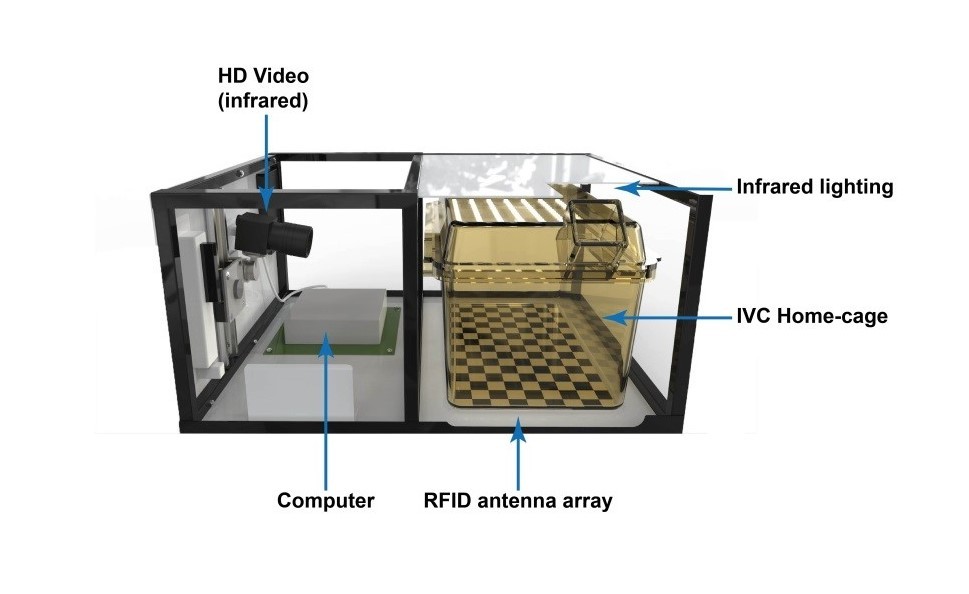Rodent Big Brother: The Trurat Show

At a glance
R
- Refinement
Contents
Overview
Animals used in safety pharmacology studies inform the decision to progress new drugs further in the drug development process towards the clinic. The temperature and activity of these animals are recorded to monitor their welfare and the effects of the study compound. Behaviour is monitored by trained scientists using singly housed animals, often held in bespoke cages. Behavioural analysis generally requires manual observation by experienced observers, usually limited to ‘snapshots’ during the light phase when rats are less active (e.g. FOB, Irwin test). Body temperature can be measured manually at intervals, or continuously using surgically implanted telemetry transducers. These conventional approaches are not always compatible with 24 h continuous monitoring or with being performed concurrently in a repeat-dose study.
The Rodent Big Brother system developed by Actual Analytics Ltd will provide an unobtrusive technology that can be incorporated into standard IVC racks rather than as a bench top system. This technology will avoid the need for surgery or single housing, reduce the number of animals needed for a study, deliver welfare benefits to the animals used and, through the incorporation of additional measurements into existing study types reduce the number of studies needed overall.
Full details about this CRACK IT Challenge can be found on the CRACK IT website.
Impact
Actual Analytics Ltd in collaboration with Challenge Sponsors AstraZeneca has developed the innovative rodent home cage behavioural monitoring system, the Home Cage Analyser (HCA). The system provides minimally-invasive, 24/7 automated monitoring of individual rat’s behavior (ambulatory activity, eating, drinking and rearing) and temperature while group-housed in a standard unmodified home cage. When used in safety pharmacology studies, the system avoids the need for surgery or single housing, reduces the number of animals needed, delivers welfare benefits to the animals used and, through the incorporation of additional measurements into existing study types, reduces the number of studies needed overall.
The HCA system fits into two rack spaces of standard IVC racks without modifying the home cage (Figure 1). Each animal is tagged subcutaneously in the ventral midline with a radiofrequency identification (RFID) chip to record temperature, location and identity using a 2D array of RFID readers that sit underneath each cage. The cage is illuminated by infrared LED lighting and a side-view HD camera captures recordings of rat behaviour. The video and baseplate data is processed using a small computer, and trained software detects specific behaviours.

Figure 1. An illustration of the Home Cage Analysis system with the key components highlighted.
AstraZeneca conduced proof-of-principle studies of the HCA system using three reference drugs (chlorpromazine and clonidine (sedatives), and amphetamine (stimulant)) and demonstrated that the HCA could detect changes in ambulatory activity, vertical activity and subcutaneous temperature in group housed animals consistent with effects seen in the conventional modified Irwin test (mIT), but extending into the 24 hour profile (Tse et al., 2018). The HCA also detected effects that were missed by the mIT, highlighting the benefits of continuous monitoring.
Although the system was developed initially for use by the pharmaceutical industry to support safety studies, the system also has broad applicability across a wide range of research areas including phenotyping and pharmacological profiling of new disease models.
Actual Analytics was awarded the contract for the CRACK IT Challenge Rodent Little Brother and has developed a system for mice.
Actual Analytics was awarded funding through the NC3Rs technology partnering hub CRACK IT Solutions to expand the scope of the system. Actual Analytics worked with researchers from Queen Mary, University of London to validate the system for longitudinal monitoring of home cage behavior and welfare in animals undergoing spinal cord or brain injury procedures https://www.nc3rs.org.uk/rodent-big-brother.
The NC3Rs in collaboration with Actual Analytics and AstraZeneca held a one day workshop to showcase the rodent HCA system to potential industry users. Further information can be found here.
The HCA system for rats and mice is commercially available to purchase and has been implemented by a number of CROs, research institutes and pharmaceutical companies. For more information about the HCA system, please visit the Actual Analytics website or alternatively contact Actual Analytics at getintouch@actualanalytics.com.
Publications
Tse K et al. (2018). Pharmacological validation of individual animal locomotion, temperature and behavioural analysis in group-housed rats using a novel automated home cage analysis system: A comparison with the modified Irwin test. Journal of Pharmacological and Toxicological Methods. doi.org/10.1016/j.vascn.2018.03.008.
Redfern WS et al. (2017). Automated recording of home cage activity and temperature of individual rats housed in social groups: The Rodent Big Brother project. PLoS ONE doi.org/10.1371/journal.pone.0181068.
Tse K et al. (2015). Rodent Big Brother: A home cage automated behavioural monitoring system for safety pharmacology toxicology studies. Safety Pharmacology Society 15th Annual Meeting, Prague, Czech Republic. doi.org/10.1016/j.vascn.2016.02.013.
Redfern WS et al. (2014). Rodent Big Brother: Development and validation of a home cage automated behavioural monitoring system for use in repeat-dose toxicity studies in rats. Eurotox 50th Congress, Edinburgh, UK. Toxicology Letters 229: S47-48. doi.org/10. 1016/j.vascn.2015.08.012.
Redfern WS et al. (2013). Functional Assessments in Repeat-dose Toxicity Studies: The Art of the Possible. Toxicology Research 2: 209-234.doi 10.1039/C3TX20093K
Posters
Ajeesh Koshy Cherian, Chiara Giuliano, Ian Ragan, Aileen Milne, Joanne Sutherland, Mike Rolf, Greet Teuns, Francesca Pibin, Eric I Rossman, Michelle McClafferty, J. Douglas Armstrong, Rowland Sillito, Anthony Holmes. (2022). The Results of a Multi-Company Validation of the ActualHCATM Home Cage Monitoring System for Rodent CNS Safety Pharmacology Studies.
Chiara Giuliano, Ian Ragan, Aileen Milne, Joanne Sutherland, Mike Rolf, Greet Teuns, Eric I Rossman, Michelle McClafferty, Ajeesh Koshy Cherian, J. Douglas Armstrong, Rowland Sillito, Anthony Holmes. (2021). Multi-Company Validation of the ActualHCATM Home Cage Monitoring System for Rodent CNS Safety Pharmacology Studies.
Karen Tse, Amy Keerie, Rowland Sillito, Rachel Collier, Mark Pilling, Catherine Vickers, Kathryn Chapman, J Douglas Armstrong, William S Redfern. (2016). Continuous monitoring of individual rats when group-housed in the home cage to assess drug-induced changes in activity and temperature.
Karen Tse, Amy Keerie, Rowland Sillito, Rachel Collier, Claire Grant, Catherine Vickers, Kathryn Chapman, J Douglas Armstrong, Will S Redfern. (2016). Rodent Big Brother: A Comparison to the Modified Irwin Test for Assessing Drug-Induced Changed in Activity and Temperature in Rats.
Karen Tse, Amy Keerie, Agisilaos Chartsias, Rowland Sillito, John Pedersen, Stephanie Klein, Catherine Vickers, Kathryn Chapman, J Douglas Armstrong, Will S Redfern. (2016). Rodent Big Brother: Optimal Location and Orientation of the Subcutaneous RFID microchip Transponder for Home Cage 24/7 Monitoring in Rats.
2017 workshop
In collaboration with AstraZeneca and Actual Analytics, we hosted a one-day workshop in central London on 5 June 2017 to showcase the rodent home cage behavioural monitoring system, the Home Cage Analyser (HCA), developed by Actual Analytics through the Rodent Big Brother (RBB) CRACK IT Challenge. A report summarising the outputs of the workshop can be downloaded here.
The HCA provides continual, minimally-invasive, 24/7 automated monitoring of individual rat’s ambulatory activty, behaviour and temperature while group-housed in a standard, unmodified home cage. Benefits of the system include improved animal welfare, improved data quality and a reduction in animal numbers.
The workshop brought together individuals from the pharmaceutical industry, contract research organisations and international regulatory agencies with the aims of:
-
Providing background on the development, validation and application of the HCA.
-
Identifying the opportunities and barriers to using home cage monitory systems on preclinical safety studies.
-
Agreeing a strategy to facilitate the uptake and application of home cage behavioural monitoring systems on preclinical safety studies to maximise the scientific and 3Rs benefits of the system.
The workshop included presentations from AstraZeneca describing the RBB Challenge and validation of the HCA, as well as showcasing some of the proof-of-concept work using the system to investigate the full behavioural profile of two drugs. Actual Analytics presented on the technical development of the HCA. These presentations, containing audio commentary, can be accessed below.
